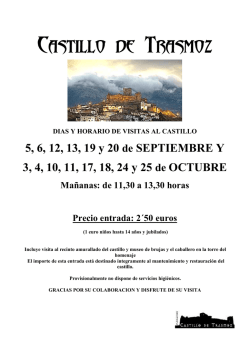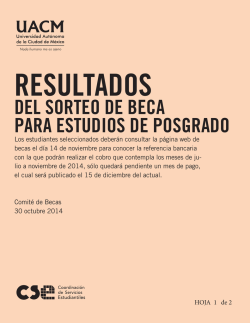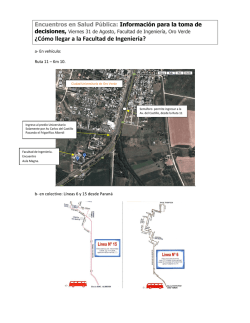
Folleto Vive la Historia. Parador de Tortosa
Vive la Historia Live the History PARADOR DE TORTOSA Entre Al Andalus y la Marca Superior, lo que ahora es Tarragona, existió un reino de taifa independiente. Allí, sobre un promontorio que fue acrópolis romana, una impresionante alcazaba árabe dominaba la ciudad medieval. Una vez reconquistada, el castillo cristiano se convirtió en el guardián de la ciudad y de la cuenca baja del Ebro. Between Al Andalus and the Upper March, in what is now Tarragona, there existed an independent Taifa Kingdom. There on a promontory which was a Roman acropolis, an impressive Arab fortress dominated the medieval city. Once reconquered, the Christian castle became the guardian of the city and the lower basin of the River Ebro. En el castillo de la Zuda se ubica, desde 1976, el Parador de Tortosa. Es un edificio de nueva planta integrado en el conjunto de un castillo cuyo nombre, Zuda, hace referencia al gigantesco pozo que mandaron construir allí los árabes al convertirlo en alcazaba en el siglo X. De esa época quedan, también, el cementerio, el único al descubierto de Cataluña y el trazado de las murallas. La fortaleza fue conquistada en 1148 y el cerro fue dividido, como botín de guerra, entre los vencedores: los genoveses, los Montcada y los templarios. Poco después, Ramón Berenguer compró su parte a los genoveses y, en 1182, el rey Alfonso I lo cedió a los templarios, de ahí que este castillo se identifique siempre con la Orden del Temple. El castillo tuvo una función defensiva sobre el bajo Ebro pero, en ocasiones, fue residencia real, como cuando la ocupó Jaime I. De este rey se dice también que tenía una especial debilidad por este castillo desde el que planeó la conquista de Valencia. Entre los siglos XVI y XVII fue un fortín y sufrió daños irreparables durante las guerras de Sucesión y contra los franceses ya en el siglo XIX. La Guerra Civil aceleró su destrucción. The Parador of Tortosa has been located in the Castillo de la Zuda since 1976. It is a newly designed building integrated into the complex of the castle whose name, Zuda, refers to the gigantic well which the Arabs ordered to be built there when they transformed it into a fortress in the X century. The cemetery, the only exposed cemetery in Catalonia, and the trajectory of the walls also remain from this epoch. The fortress was conquered in 1148 and the hill was divided as plunder of war among victors: the Genovese, the Montcada and the Templars. A short time later, Ramón Berenguer bought the part of the Genovese and, in 1182, King Alfonso I ceded it to the Templars, thus this castle has always been identified with the Order of the Temple. The castle had a defensive function over the lower River Ebro but, on occasions, it was a royal residence, as when it was occupied by Jaime I. This king is also said to have a special weakness for this castle from when he planned the conquest of Valencia. Between the XVI and XVII centuries, it was a fort and underwent irreparable damage during the Wars of Succession and against the French in the XIX century. The Civil War accelerated its destruction. LOS TEMPLARIOS EN LA CORONA DE ARAGÓN La Orden del Temple nació en 1120 en Jerusalén para proteger a los peregrinos de Tierra Santa pero pronto se convirtió en una importante fuerza militar que llegó a tener más de mil castillos entre Europa y Oriente. A la Corona de Aragón llegaron en el siglo XII y se incorporaron al esfuerzo reconquistador de los reyes cristianos. Sus éxitos militares y su contribución al avance territorial les confirieron prestigio y un gran poder que controlaban a través de sus fortalezas y encomiendas. Cuando en 1307 el papa ordenó la disolución de la orden, algunos de estos castillos opusieron una feroz resistencia que duró meses de asedio. Asedio a un castillo, extraído de “La gran conquista de ultramar” (Biblioteca Nacional de España) THE TEMPLARS OF THE CROWN OF ARAGON The Order of the Temple was established in 1120 in Jerusalem in order to protect the pilgrims to the Holy Land, but it soon became an important military force the East. They arrived in Aragon in the XII century and joined the efforts of the Christian Kings to reconquer the land. Their military successes and their contribution to the territorial advance brought them prestige and a strong power which they controlled through their fortresses and encomiendas. When the Pope ordered the dissolution of the Order in 1307, some of these castles put up fierce resistance and the sieges lasted for months. UN CEMENTERIO ÁRABE EN TORTOSA En el castillo apareció, en 1973, una lápida funeraria. Es la pieza arqueológica más destacada de la necrópolis árabe del castillo, una de las más importantes de Cataluña. Se trata de un personaje ilustre, el gobernador Qaid Abd Al-Salamb, que murió el 7 de enero del 961. La lápida es de mármol con una bella escritura cúfica de traza florida en altorrelieve que hace mención a la vida más allá de la muerte y a preceptos religiosos coránicos. AN ARAB CEMETERY IN TORTOSA A tombstone appeared in the castle in 1973. It is the most outstanding archaeological piece of the Arab necropolis of the castle, one of the most important in Catalonia. It is the tombstone of an illustrious personage, the Governor, Qaid Abd Al-Salamb, who died on January 7, 961. The tombstone is made of marble with beautiful, florid, kufic script in relief which mentions life beyond death and religious precepts from the Koran. TAMBIÉN LE GUSTARÁ: YOU WILL ALSO LIKE THE FOLLOWING: Ruta de los castillos templarios en la Corona de Aragón: Tortosa-Miravet-Monzón-Gardeny y Peñíscola. Route of the Templar Castles within the Crown of Aragon: Tortosa-Miravet-Monzón-Gardeny and Peñíscola Categoría: Castillo Fecha: 1976 Arquitecto: Ignacio Gárate BIC: Monumento Category: Castle Date: 1976 Architect: Ignacio Gárate BIC (Property of Cultural Interest): Monument
© Copyright 2025


